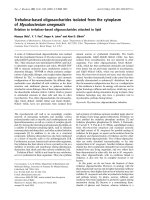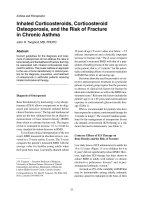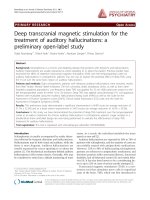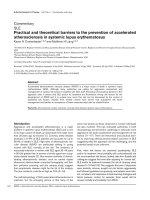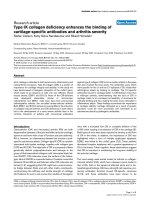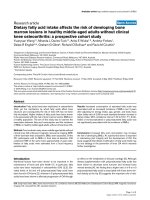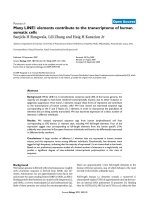Báo cáo y học: " A double shunt technique for the prevention of ischaemia of a congenital, solitary, pelvic kidn" pps
Bạn đang xem bản rút gọn của tài liệu. Xem và tải ngay bản đầy đủ của tài liệu tại đây (739.94 KB, 4 trang )
CAS E REP O R T Open Access
A double shunt technique for the prevention of
ischaemia of a congenital, solitary, pelvic kidney
during abdominal aortic aneurysm repair: a case
report
Sotirios A Makris
1*
, Eleftherios Kanellopoulos
1
, Anastasios Chronopoulos
1
, Thomas G Vrachliotis
2
,
Nikolaos Doundoulakis
1
Abstract
Introduction: Congenital solitary pelvic kidney is a rare condition, and its association with an abdominal aortic
aneurysm is even more unusual. To the best of our knowledge, only two such cases have been reported in the
literature to date.
Case presentation: We report the case of a 59-year-old Caucasian man with a congenital solitary pelvic kidney,
who was found to have an abdominal aortic aneurysm 83 mm in diameter. Abdominal computed tomography
angiography clearly identified two renal arteries, one originating from the aortic bifurcation. and the other from the
proximal portion of the right common iliac artery. At surgery, renal ischaemia was prevented by introduction of an
axillofemoral shunt (consisting of two femoral cannulas and a vent tube of extracorporeal circulation) from the
right axillary to the right femoral artery, and a second Argyle shunt from the right common iliac artery to the
origin of the left renal artery. A 20 mm Dacron tube graft was then implanted. Our patient’s postoperative renal
function was normal.
Conclusion: The renal preservation double shunt technique used in this case seems to be effective during
abdominal aortic aneurysm repair.
Introduction
Congenital solitary pelvic kidney (CSPK) has been
reported to be present in 1 in 22,000 post-mortem
examinations [1]. The combination of this rare renal
anomaly with an abdominal aortic aneurysm (AAA)
poses a therapeutic challenge because, by definition,
supra renal aortic clamping is always mandatory in these
cases. Therefore, patients with these concomitant disor-
ders are at high risk of developing renal ischaemia dur-
ing conventional open repair of their aneurysm. We
describe and comment on our experience of managing a
case with this dual pathology.
Case presentation
A 59-year-old Caucasian man was referred to our vascu-
lar department with a pulsatile abdominal mass around
the umbilicus. He had a known history of a solitary pel-
vic kidney. This congenital anomaly had been diagnosed
during evaluation of recurrent urinary tract infections
10 years previously.
On physical exami nation, lower extremity pulses (that
is, anterior a nd posterior tibial arteries) were palpable,
without evidence of other arterial aneurysms. Our
patient was a hea vy smoker (100 pack-y ears; approxi-
mately 50 cigarettes/day for 40 years), and his medical
history also included hypertension and hyperlipidaemia,
both well controlled on monotherapy. Laboratory tests,
chest radiography and electro cardiography were normal.
Serum creatinine level was 1.3 mg/dL(0.16 mmol/L)
[normal range 0.7 to 1.3 mg/dL (0.06 to 0.11 mmol/L)].
Computed tomography angiography (CTA) revealed an
* Correspondence:
1
Department of Vascular and Endovascular Surgery, Henry Dunant Hospital,
107 Mesogion Ave, Athens, 11526, Greece
Full list of author information is available at the end of the article
Makris et al. Journal of Medical Case Reports 2011, 5:92
/>JOURNAL OF MEDICAL
CASE REPORTS
© 2011 Makris et al; licensee BioMed Central Ltd. This is an Open Access article distributed under the terms of the Creative Commons
Attribution License ( which permits unrestricted use, distribution, and reproduction in
any medium, provided the original work is properly cited.
83 mm abdominal aortic aneurysm, and verified the pre-
sence of a solitary pelvic kidney. The renal arterial ana t-
omy was also examined; a large, predominant artery
from the aortic bifurcation supplied the left portion of
the renal parenchyma (hereafter referred to as ‘left renal
artery’) and a smaller vessel (right renal artery) a rose
from the proximal portion of the right co mmon iliac
artery (Figure 1). An intravenous excretory pyelography
was then performed, and clearly showed the single fused
renal mass lying in the middle of the pelvis and contain-
ing two separate, well-formed and of normal size and
course collecting systems.
It was apparent on the one hand that no attempt of
endovascular exclusion of the aneurysm could be per-
formed without compromising the renal blood supply.
On the other hand, surgical implantation of a graft needs
to be individually designed and focus ed on the preven-
tion of renal ischaemia. This particular problem was
solved by creating an axillofemoral shunt similar to a
long Javit-li ke shunt used for carotid surgery. This shunt
was composed of a 22 Fr femoral cannula (Edwards Life-
sciences, Irvine, CA, USA), a half-inch Vent tube
(Maquet Cardiopulmonary, Hirrlinger, Germany) for
extracorporeal circulation with a one-way valve, followed
by a second 22 Fr femoral cannula (Figure 2).
We performed elective resection of the aneurysm via a
midline incision and transperitoneal exposure of the
aorta. Both common iliac arteries and the left renal
artery were dissected a nd controlled with vessel loops.
The right a xillary and c ommon femoral arteries were
then exposed via separate incisions, and the cannulae o f
the axillofemoral shunt were placed in them through
small arteriotomies. The distal common femoral artery
was clamped to improve retrograde perfusion to the
kidney. Diuresis was induced with mannitol (12.5 g
intravenously) and anticoagulation was initiated with
intravenous heparin (7,500 U). The aorta and both com-
mon ili ac arteries were cross-clamped. The right com-
mon iliac artery clamp was applied proximally to the
right renal artery origin, allowing backflow perfusion of
the right moiety of the renal parenchyma. The aneurys-
mal sac was then opened, the left renal artery orifice
was identified, and a 12 Fr Argyle shunt (Tyco Health-
care, Tullamore, Co. Tipperary, Ireland) was inserted
into it. The other edge of this shunt was positioned into
the right common iliac artery, thus blood flow was
retained to the left half of the solitary kidney (Figure 3).
A 20 mm tube D acron graft was then interposed, and
the procedure was ca rried out without further difficulty.
The selection of the graft size was based upon the wide
width of the aortic bifurcation. The total time of renal
ischaemia did not exceed five minutes.
Our patient was extubated the same day in the inten-
sive care unit. His renal function and blood pressure
remained unchan ged throughout his hospital stay (diur-
esis greater than 60 ml/hr, creatinine levels <1.1 mg/dL
(0.097 mmol/L)). He had prolonged paralytic ileus,
which responded well to supportive therapy, without
evidence of bowel obstruction or ischaemia. Pneumonia
also developed on the fourth postoperative day, but
Figure 1 Pre-operative computed tomography angiography of
a 59-year-old patient revealed an asymptomatic abdominal
aortic aneurysm, and a solitary pelvic kidney, and the
composition of the renal vasculature. One renal artery originated
from the aortic bifurcation and the other from the proximal portion
of the right common iliac artery (yellow arrows).
Figure 2 The first shunt. The axillofemoral shunt consisting of two
22 Fr femoral cannulas connected to each other with a half-inch
Vent tube of extracorporeal circulation and an one-way valve,
similar to a custom-made long Javit-like shunt used in carotid
surgery.
Makris et al. Journal of Medical Case Reports 2011, 5:92
/>Page 2 of 4
responded well to intravenous administration of antibio-
tics, allowing discharge on the ninth postoperative day.
There was no rise in ren al retention values and no dete-
rioration of the existing hypertension during 24 mo nths
of follow-up. Subseq uent CTA confirmed the successful
result (Figure 4).
Discussion
The combination of a CSPK with an AAA is exceedingly
rare. Several maneuvers have been proposed to maintain
blood flow to solitary , ectopic or transplan ted pelvic
kidneys during aortic cross-clamping. Axillofemoral
[2,3] or temporary abdominal in-line (Gott) [2,4] sh unts
are considered an excellent solution, but their placement
can be difficult and time-consuming. The double proxi-
mal clamping technique, as described by Lacombe [5]
and modified by Hollis [6], represents an effective
alternative, as groin incisions are avoided. However, it
requires adequate patent lumbar circulation, and
manipulation of the aneurysmal sac could potentially
lead to distal embolization.
To the best of our knowledge, this is only the third
publication in the literature describing the m anagement
of CSPK wi th AA A. Ka plan et al.firstpresenteda
patient with a single renal artery arising from the right
common iliac artery [7]. The AAA was successfully
repaired endoluminally with a tube stent graft, and no
further attempt of preservation of renal blood flow was
made. However, tube endografts are nowadays consid-
ered obsolete and have been abandoned since the early
1990 s. However, fixation of a second-generation stent
graft usually necessitates the sacrifice of aberrant or
accessory renal arteries originat ing from the aneurysmal
sac or most commonly, from the iliac vessels, and there-
fore, minimal invasive endovascular repair cannot be
used in patients with CPSK. In our case, it was obvious
that the placement of the limb of a bifurcated graft or
the contralateral occluder of an aortic-unifemoral device
Figure 3 The second shunt. When the aneurysmal sac was opened, the left renal artery orifice was located, and an Argyle shunt was placed
from the right common iliac artery (yellow arrow) to the left renal artery orifice (green arrow), allowing the whole renal parenchyma to be
adequately perfused.
Makris et al. Journal of Medical Case Reports 2011, 5:92
/>Page 3 of 4
would result in disastrous renal infarction and subse-
quent functional impairment.
Murakami et al also reported a 77-year-old patient
with an AAA associated with a CSPK, which was sup-
plied by two aberrant renal arteries [8], one originating
fromtheaorticwalljustabovetheaorticbifurcation,
and the other from the left common iliac artery. The
aneurysm was repaired by interposition of a tube graft.
Renal preservation during aortic cross-clamping was
achieved by a combination of in situ cold perfusion and
topical ice slush. Their patient’screatininevaluesdid
not show any significant elevation at the time of dis-
charge. Although cooling techniques and in situ
hypothermic perfusion should prevent renal ischaemia
for more than an hour [9], we felt that shunting offered
the best protection for our patient.
Conclusion
In conclusion, the presence of CSPK in conjunction
with AAA si gnificantly complicates aortic reconstructive
surgery, and demands careful planning. The optimal
operative management and the appropriate method of
preservation of renal blood supply must be selected
individually, based on anatomic considerations and the
surgeon’ s opinion. A variety of protective techniques,
including shunting, cooling and passive use of collaterals
have been used to prevent intra-operative renal ischae-
mia. The double shunt technique described above can
be safely accomplished with favorable results.
Consent
Written informed consent was obtained from the patient
for publication of this case report and accompanying
images. A copy of the written consent is available for
review by the Editor-in-Chief of this journal.
Author details
1
Department of Vascular and Endovascular Surgery, Henry Dunant Hospital,
107 Mesogion Ave, Athens, 11526, Greece.
2
Department of Interventional
Radiology, Henry Dunant Hospital, 107 Mesogion Ave Athens, 11526, Greece.
Authors’ contributions
SAM, EK, AC and ND planned and performed the operation. TGV interpreted
the CT angiography and gave specific information about the vascular
anatomy of the pelvic kidney. All authors read and approved the final
manuscript.
Competing interests
The authors declare that they have no competing interests.
Received: 21 October 2009 Accepted: 6 March 2011
Published: 6 March 2011
References
1. Bauer SB, Perlmutter AD, Retik AB: Anomalies of the upper urinary tract. In
Campbell’s Urology. 6 edition. Edited by: Walsh PC. Philadelphia: WB
Saunders; 1992:1357-442.
2. Kashyap VS, Quiñones-Baldrich WJ: Abdominal aortic aneurysm repair in
patients with renal allografts. Ann Vasc Surg 1999, 13:199-203.
3. Giulini SM, Maffeis R, Cangiotti L, Bonardelli S, Bertoloni G, Caratozzolo E:
Temporary axillo-femoral bypass graft for renal transplant protection
during aortic aneurysm repair. J Cardiovasc Surg 1996, 37:575-8.
4. O’Mara CS, Flinn WR, Bergan JJ, Yao JST: Use of a temporary shunt for
transplant protection during aortic aneurysm repair. Surgery 1982,
94:512-15.
5. Lacombe M: Abdominal aortic aneurysmectomy in renal transplant
patients. Ann Surg 1985, 203:62-68.
6. Hollis HW Jr, Rutherford RB, Crawford GJ, Cleland BP, Marx WH, Clark JR:
Abdominal aortic aneurysm repair in patients with pelvic kidney.
Technical considerations and literature review. J Vasc Surg 1989, 9:404-9.
7. Kaplan DB, Kwon CC, Marin ML, Hollier LH: Endovascular repair of
abdominal aortic aneurysms in patients with congenital renal vascular
anomalies. J Vasc Surg 1999, 30:407-15.
8. Murakami T, Makino Y, Suto Y, Yasuda K: Abdominal aortic aneurysm
repair in a patient with a congenital solitary pelvic kidney. A case
report. J Cardiovasc Surg 2004, 45:501-4.
9. Bui TD, Wilson SE, Gordon IL, Fujitani RM, Carson J, Montgomery RS: Renal
function after elective infrarenal aortic aneurysm repair in patients with
pelvic kidneys. Ann Vasc Surg 2007, 21:143-8.
doi:10.1186/1752-1947-5-92
Cite this article as: Makris et al.: A double shunt technique for the
prevention of ischaemia of a congenital, solitary, pelvic kidney during
abdominal aortic aneurysm repair: a case report. Journal of Medical Case
Reports 2011 5:92.
Figure 4 Follow-up two years after computed tomography
angiography.
Makris et al. Journal of Medical Case Reports 2011, 5:92
/>Page 4 of 4
